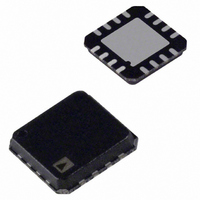ADA4938-1ACPZ-R2 Analog Devices Inc, ADA4938-1ACPZ-R2 Datasheet - Page 18

ADA4938-1ACPZ-R2
Manufacturer Part Number
ADA4938-1ACPZ-R2
Description
IC ADC DRIVER DIFF 16-LFCSP
Manufacturer
Analog Devices Inc
Type
ADC Driverr
Datasheet
1.ADA4938-1ACPZ-R7.pdf
(28 pages)
Specifications of ADA4938-1ACPZ-R2
Applications
Data Acquisition
Mounting Type
Surface Mount
Package / Case
16-LFCSP
No. Of Amplifiers
1
Input Offset Voltage
4mV
Gain Db Max
1.05dB
Bandwidth
1GHz
Slew Rate
4700V/µs
Supply Voltage Range
4.5V To 11V
Supply Current
37mA
Amplifier Case Style
LFCSP
Rohs Compliant
Yes
Lead Free Status / RoHS Status
Lead free / RoHS Compliant
ADA4938-1/ADA4938-2
TERMINOLOGY
Differential Voltage
The differential voltage is the difference between two node
voltages. For example, the output differential voltage (or
equivalently, output differential-mode voltage) is defined as
where V
−OUT terminals with respect to a common reference.
V
OUT, dm
V
+OUT
OCM
–FB
+FB
= (V
and V
R
R
G
G
+OUT
−OUT
R
R
Figure 57. Circuit Definitions
F
F
− V
refer to the voltages at the +OUT and
+IN
–IN
−OUT
ADA4938
)
–OUT
+OUT
R
L, dm
V
OUT, dm
Rev. A | Page 18 of 28
Common-Mode Voltage
The common-mode voltage is the average of two node voltages.
The output common-mode voltage is defined as
Balance
Balance is a measure of how well differential signals are matched in
amplitude and are exactly 180° apart in phase. Balance is most
easily determined by placing a well-matched resistor divider
between the differential voltage nodes and comparing the
magnitude of the signal at the midpoint of the divider with
the magnitude of the differential signal. By this definition,
output balance is the magnitude of the output common-mode
voltage divided by the magnitude of the output differential
mode voltage.
V
Output
OUT, cm
= (V
Balance
+OUT
+ V
Error
−OUT
=
)/2
V
V
OUT
OUT
,
,
dm
cm
















